NCERT Solutions for Class 12 Maths Chapter 6 - Application of Derivatives - Exercise 6.1
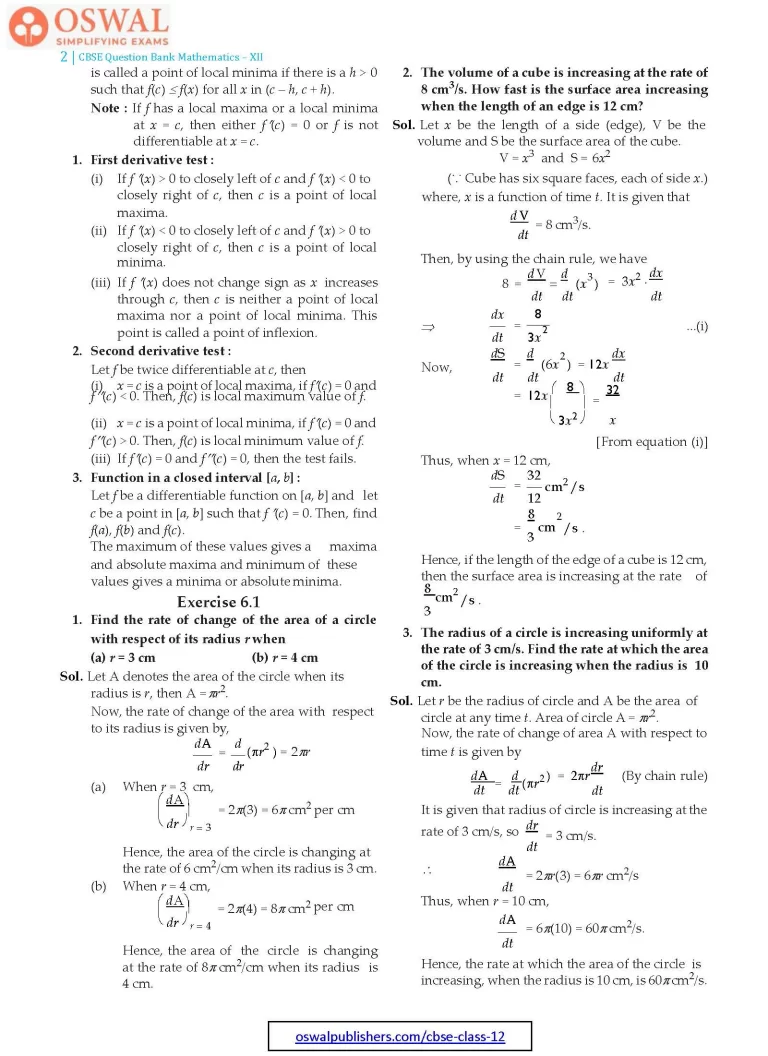
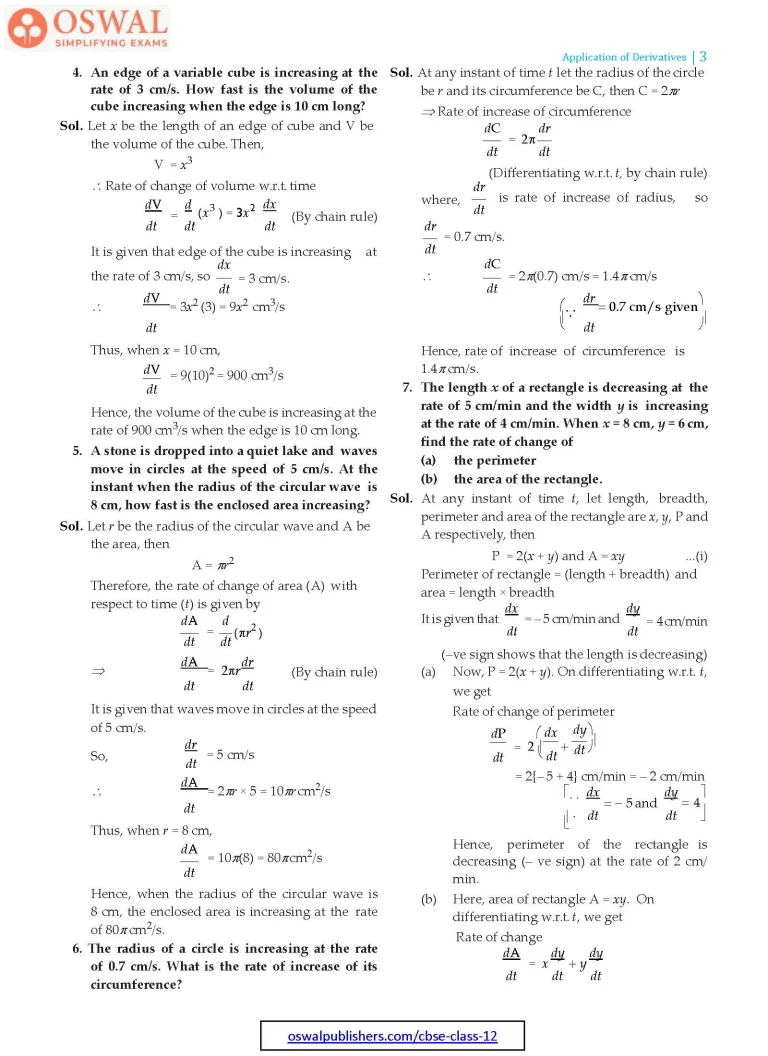
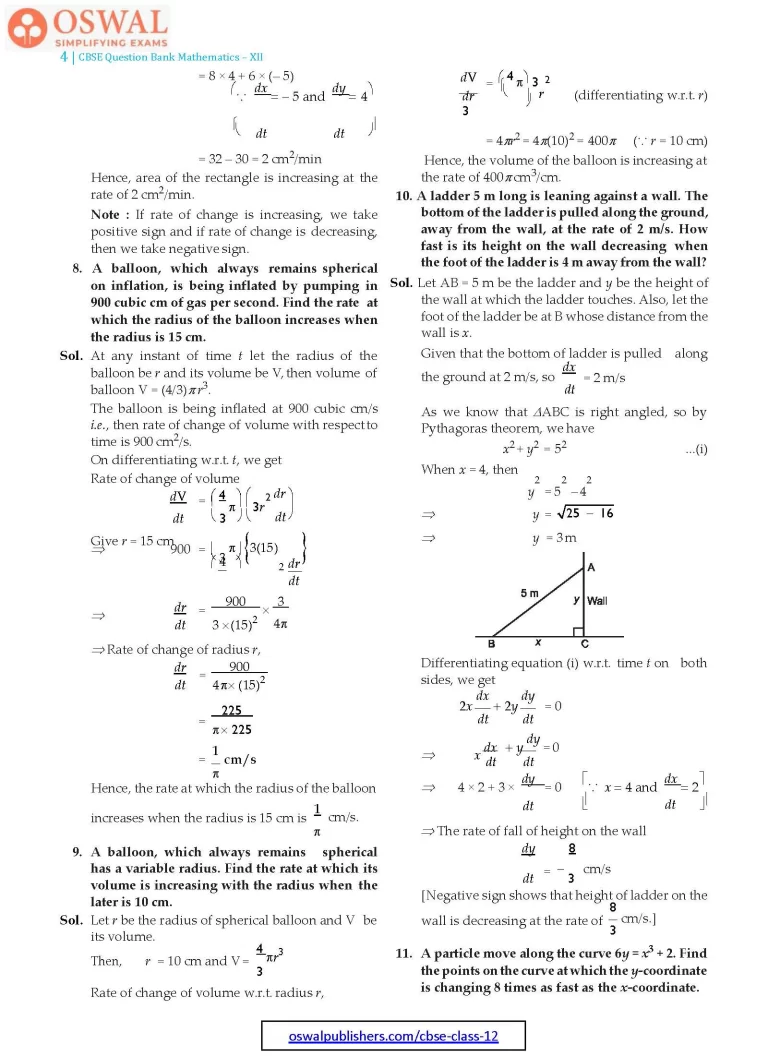
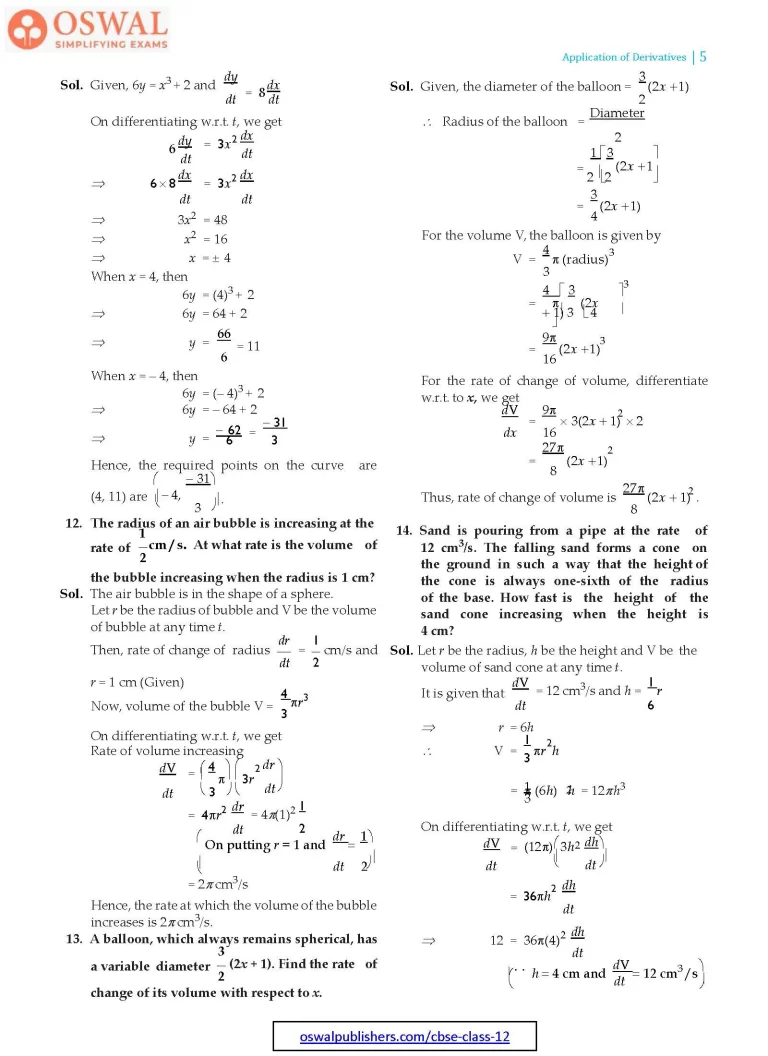
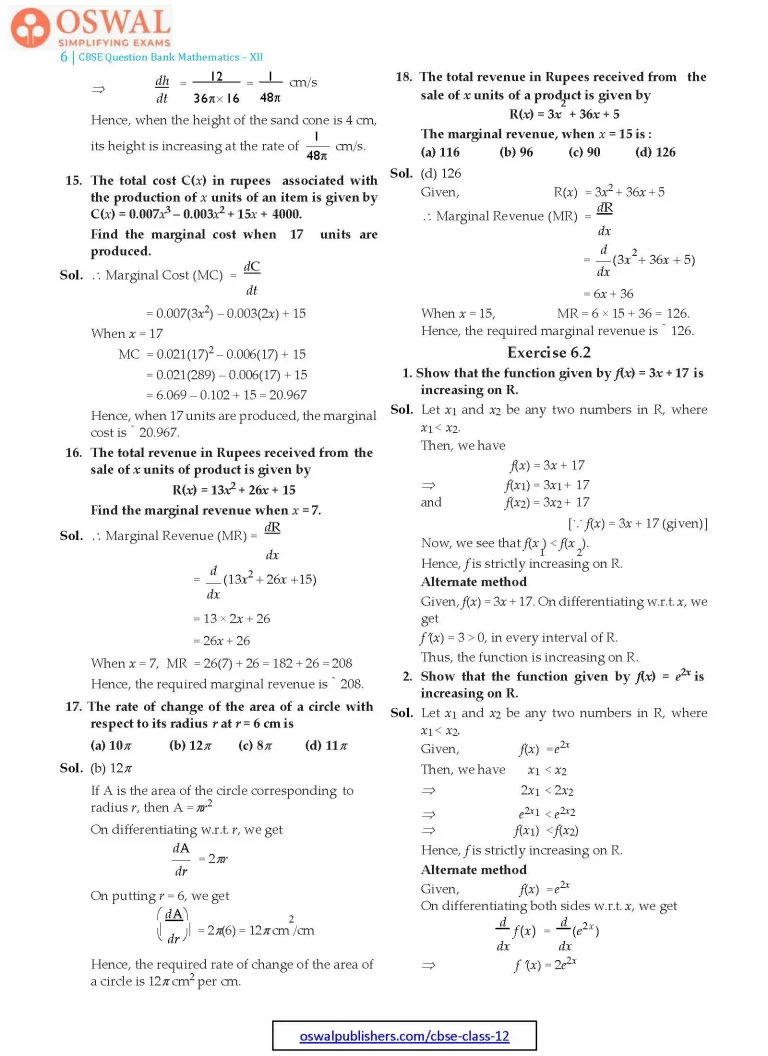
Access Exercises of Class 12 Maths Chapter 6 Application of Derivatives
Exercise 6.1 Solutions: 18 Questions (10 Long, 6 Short, 2 MCQs)
Exercise 6.2 Solutions: 19 Questions (10 Long, 7 Short, 2 MCQs)
Exercise 6.3 Solutions: 27 Questions (14 Long, 11 Short, 2 MCQs)
Exercise 6.4 Solutions: 9 Questions (7 Short, 2 MCQs)
Exercise 6.5 Solutions: 29 Questions (15 Long, 11 Short, 3 MCQs)
Miscellaneous Exercise Solutions: 24 Questions (14 Long, 4 Short, 6 MCQs)
Exercise 6.1
1. Find the rate of change of the area of a circle with respect of its radius r when
(a) r = 3 cm (b) r = 4 cm
Sol. Let A denotes the area of the circle when its radius is r, then A = πr2.
Now , the rate of change of the area with respect to its radius is given by,
$$\frac{\text{dA}}{\text{dr}}=\frac{d}{dr}(\pi r^2)=2\pi r$$
(a) When r = 3 cm,
$$\bigg(\frac{\text{dA}}{dr}\bigg)_{r=3}=2\pi(3)$$
= 6π cm2 per cm
Hence, the area of the circle is changing at the rate of 6 cm2/cm when its radius is 3 cm.
(b) When r = 4 cm,
$$\bigg(\frac{dA}{dr}\bigg)_{r=4}=\text{2}\pi(4)\\=8\pi\space\text{cm}^2\text{per cm}$$
Hence, the area of the circle is changing at the rate of 8π cm2/cm when its radius is 4 cm.
2. The volume of a cube is increasing at the rate of 8 cm3/s. How fast is the surface area increasing when the length of an edge is 12 cm?
Sol. Let x be the length of a side (edge), V be the volume and S be the surface area of the cube.
V = x3 and S = 6x2
(∵ Cube has six square faces, each of side x.)
where, x is a function of time t. It is given that
$$\frac{dV}{dt}= 8\space\text{cm}^3/s. $$
Then, by using the chain rule, we have
$$8=\frac{dV}{dt}=\frac{d}{dt}(x^3)\\=3x^2.\frac{dx}{dt}\\\Rarr\space\frac{dx}{dt}=\frac{8}{3x^2}\space\text{...(i)}\\\text{Now,\space}\frac{dS}{dt}=\frac{d}{dt}(6x^2)\\=12x\frac{dx}{dt}\\=12x\bigg(\frac{8}{3x^2}\bigg)=\frac{32}{x}$$
[From equation (i)]
Thus, when x = 12 cm,
$$\frac{dS}{dt}=\frac{32}{12}\space\text{cm}^2/s\\=\frac{8}{3}\space\text{cm}^2/s.$$
Hence, if the length of the edge of a cube is 12 cm, then the surface area is increasing at the rate of
$$\frac{8}{3}\space\text{cm}^2/s.$$
3. The radius of a circle is increasing uniformly at the rate of 3 cm/s. Find the rate at which the area of the circle is increasing when the radius is 10 cm.
Sol. Let r be the radius of circle and A be the area of circle at any time t. Area of circle A = πr2.
Now , the rate of change of area A with respect to time t is given by
$$\frac{\text{dA}}{\text{dt}}=\frac{d}{dt}(\pi r^2)= 2\pi r\space\frac{dr}{dt}\\\text{(By chain rule)}$$
It is given that radius of circle is increasing at the rate of 3 cm/s,
$$\text{so}\space\frac{dr}{dt}=\text{3 cm/s}.\\\therefore\space\frac{dA}{dt}=2\pi r(3)=6\pi r\space\text{cm}^2/s$$
Thus, when r = 10 cm,
$$\frac{\text{dA}}{dt}=6\pi(10)= 60\pi\space\text{cm}^2/s.$$
Hence, the rate at which the area of the circle is increasing, when the radius is 10 cm, is 60π cm2/s.
4. An edge of a variable cube is increasing at the rate of 3 cm/s. How fast is the volume of the cube increasing when the edge is 10 cm long?
Sol. Let x be the length of an edge of cube and V be the volume of the cube. Then,
V = x3
∴ Rate of change of volume w.r.t. time
$$\frac{dV}{dt}=\frac{d}{dt}(x^3)=3x^2\frac{dx}{dt}$$
(By chain ru le)
It is given that edge of the cube is increasing at the rate of 3 cm/s,
$$\text{so}\space\frac{dx}{dt}=3\space\text{cm/s}.$$
$$\therefore\space\frac{dV}{dt}= 3x^2(3)=9x^2\space\text{cm}^3/s$$
Thus, when x = 10 cm,
$$\frac{dV}{dt}=9(10)^2=900\space\text{cm}^3/s$$
Hence, the v olume of the cube is increasing at the rate of 900 cm3/s when the edge is 10 cm long.
5. A stone is dropped into a quiet lake and waves move in circles at the speed of 5 cm/s. At the instant when the radius of the circular wave is
8 cm, how fast is the enclosed area increasing?
Sol. Let r be the radius of the circular wave and A be the area, then
A = πr2
Therefore, the rate of change of area (A) with respect to time (t) is given by
$$\frac{dA}{dt}=\frac{d}{dt}(\pi r^2)\\\Rarr\space\frac{dA}{dt}=2\pi r\frac{dr}{dt}\space\\\text{(\text{By chain rule})}$$
It is given that waves move in circles at the speed of 5 cm/s.
$$\text{So,}\space\frac{dr}{dt}=\text{5 cm/s}\\\therefore\space\frac{dA}{dt}=2\pi r×5=10\pi r\space\text{cm}^2/s $$
Thus, when r = 8 cm,
$$\frac{dA}{dt}=10\pi(8)=80\pi\space\text{cm}^2/s$$
Hence, when the radius of the circular wave is 8 cm, the enclosed area is increasing at the rate of 80π cm2/s.
6. The radius of a circle is increasing at the rate of 0.7 cm/s. What is the rate of increase of its circumference?
Sol. At any instant of time t let the radius of the circle be r and its circumference be C, then C = 2πr
⇒ Rate of increase of circumference
$$\frac{dC}{dt}=2\pi\frac{dr}{dt}$$
(Differentiating w.r.t. t, by chain rule)
$$\text{where}\space\frac{dr}{dt}\space\text{is rate of increase of radius,}\\ \text{so}\space\frac{dr}{dt}=0.7\space\text{cm/s.}\\\therefore\space\frac{dC}{dt}=2\pi(0.7)\text{cm/s}=1.4\pi\space\text{cm/s}\\\bigg(\because\space\frac{dr}{dt}=0.7\space\text{cm}/s\space\text{given}\bigg)$$
Hence, rate of increase of circumference is 1.4π cm/s.
7. The length x of a rectangle is decreasing at the rate of 5 cm/min and the width y is increasing at the rate of 4 cm/min. When x = 8 cm, y = 6 cm, find the rate of change of
(a) the perimeter
(b) the area of the rectangle.
Sol. At any instant of time t, let length, breadth, perimeter and area of the rectangle are x, y, P and A respectively, then
P = 2(x + y) and A = xy ...(i)
Perimeter of rectangle = (length + breadth) and area = length × breadth
$$\text{It is given that}\space\frac{dx}{dt}=-5\space\text{cm/min}\\\text{and}\space\frac{dy}{dx}=4\space\text{cm/min}$$
(–ve sign shows that the length is decreasing)
(a) Now , P = 2(x + y). On differentiating w.r.t. t, we get
Rate of change of perimeter
$$\frac{dP}{dt}=2\bigg(\frac{dx}{dt}+\frac{dy}{dt}\bigg)\\=2[-5+4]\space\text{cm/min}=-2\text{cm/min}\\\bigg[\because\space\frac{dx}{dt}=-5\space\text{and}\space\frac{dy}{dt}=4\bigg]$$
Hence, perimeter of the rectangle is decreasing (– ve sign) at the rate of 2 cm/min.
(b) Here, area of rectangle A = xy. On differentiating w.r.t. t, we get
Rate of change
$$\frac{dA}{dt}=x\frac{dy}{dt}+y\frac{dy}{dt}$$
= 8 × 4 + 6 × (– 5)
$$\bigg(\because\space \frac{dx}{dt}=-5\space\text{and}\space\frac{dy}{dt}=4\bigg)$$
= 32 – 30 = 2 cm2/min
Hence, area of the rectangle is increasing at the rate of 2 cm2/min.
Note : If rate of change is increasing, we take positive sign and if rate of change is decreasing, then we take negative sign.
8. A balloon, which always remains spherical on inflation, is being inflated by pumping in 900 cubic cm of gas per second. Find the rate at which the radius of the balloon increases when the radius is 15 cm.
Sol. At any instant of time t let the radius of the balloon be r and its volume be V, then volume of balloon V = (4/3)π r3.
The balloon is being inflated at 900 cubic cm/s i.e., then rate of change of volume with respect to time is 900 cm2/s.
On differentiating w.r.t. t, we get
Rate of change of volume
$$\frac{dV}{dt}=\bigg(\frac{4}{3}\pi\bigg)\bigg(3r^2\space\frac{dr}{dt}\bigg)$$
Give r = 15 cm
$$\Rarr\space 900=\bigg(\frac{4}{3}\pi\bigg)\begin{Bmatrix}3 (15)^2\space\frac{dr}{dt}\end{Bmatrix}\\\Rarr\space\frac{dr}{dt}=\frac{900}{3×(15)^2}×\frac{3}{4\pi}$$
⇒ Rate of change of radius r,
$$\frac{dr}{dt}=\frac{900}{4\pi×(15)^2}\\=\frac{225}{\pi×225}\\=\frac{1}{\pi}\space\text{cm/s}$$
Hence, the rate at which the radius of the balloon increases when the radius is 15 cm is
$$\frac{1}{\pi}\space\text{cm/s.}$$
9. A balloon, which always remains spherical has a variable radius. Find the rate at which its volume is increasing with the radius when the later is 10 cm.
Sol. Let r be the radius of spherical balloon and V be its volume.
$$\text{Then,\space r=10 cm and V}=\frac{4}{3}\pi r^3$$
Rate of change of volume w.r.t. radius r,
$$\frac{dV}{dr}=\bigg(\frac{4}{3}\bigg)3r^2\\\text{(differentiating w.r.t. r)}$$
= 4πr2 = 4π(10)2 = 400π (∵ r = 10 cm)
Hence, the volume of the balloon is increasing at the rate of 400p cm3/cm.
10. A ladder 5 m long is leaning against a wall. The bottom of the ladder is pulled along the ground, away from the wall, at the rate of 2 m/s. How fast is its height on the wall decreasing when the foot of the ladder is 4 m away from the wall?
Sol. Let AB = 5 m be the ladder and y be the height of the wall at which the ladder touches. Also, let the foot of the ladder be at B whose distance from the wall is x.
Given that the bottom of ladder is pulled along the ground at 2 m/s,
$$\text{so}\space\frac{dx}{dt}=2\space\text{m/s}$$
As we know that ΔABC is right angled, so by Pythagoras theorem, we have
x2 + y2 = 52 ...(i)
When x = 4, then
y2 = 52 – 42
$$\Rarr\space y=\sqrt{25-16}$$
⇒ y = 3 m

Differentiating equation (i) w.r.t. time t on both sides, we get
$$2x\frac{dx}{dt}+2y\frac{dy}{dt}=0\\\Rarr\space x\frac{dy}{dt}+y\frac{dy}{dt}=0\\\Rarr\space 4×2×3×\frac{dy}{dt}=0\\\bigg[\because\space x=4\space\text{and}\space\frac{dx}{dt}=2\bigg]$$
⇒ The rate of fall of height on the wall
$$\frac{dy}{dt}=-\frac{8}{3}\space\text{cm/s}$$
[Negative sign shows that height of ladder on the wall is decreasing at the rate of
$$\frac{8}{3}\space\text{cm/s.}]$$
11. A particle move along the curve 6y = x3 + 2. Find the points on the curve at which the y-coordinate is changing 8 times as fast as the x-coordinate.
$$\textbf{Sol.}\space\text{6y = x}^3+2\space\text{and}\space\frac{dy}{dt}=8\frac{dx}{dt}$$
On differentiating w.r.t. t, we get
$$6\frac{dy}{dt}=3x^2\frac{dx}{dt}\\\Rarr\space 6×8\frac{dx}{dt}=3x^2\frac{dx}{dt}$$
⇒ 3x2 = 48
⇒ x2 = 16
⇒ x = ± 4
When x = 4, then
6y = (4)3 + 2
⇒ 6y = 64 + 2
$$\Rarr\space y=\frac{66}{6}=11$$
When x = – 4, then
6y = (– 4)3 + 2
⇒ 6y = – 64 + 2
$$\Rarr\space y=\frac{66}{6}=11$$
When x = – 4, then
6y = (– 4)3 + 2
⇒ 6y = – 64 + 2
$$\Rarr\space y=\frac{66}{6}=11$$
When x = – 4, then
6y = (– 4)3 + 2
⇒ 6y = – 64 + 2
$$\Rarr\space y=\frac{-62}{6}=\frac{31}{3}$$
Hence, the required points on the curv
e are (4, 11) are
$$\bigg(-4,\frac{-31}{3}\bigg).$$
12. The radius of an air bubble is increasing at the rate of
$$\frac{\textbf{1}}{\textbf{2}}\space\textbf{cm/s}.\space\textbf{At what rate is the volume of the}\space\\\textbf{ bubble increasing when the radius is 1 cm?}$$
Sol. The air bubble is in the shape of a sphere.
Let r be the radius of bubble and V be the volume of bubble at any time t.
$$\text{Then, rate of change of radius}\\\space\frac{dr}{dt}=\frac{1}{2}\space\text{cm/s and r = 1 cm (Given)}\\\text{Now , volume of the bubble V =}\frac{4}{3}\pi r^3$$
On differentiating w.r.t. t, we get
Rate of volume increasing
$$\frac{dV}{dt}=\bigg(\frac{4}{3}\pi\bigg)\bigg(3r^2\frac{dr}{dt}\bigg)\\=4\pi r^2\frac{dr}{dt}=4\pi(1)^2\frac{1}{2}\\\bigg(\text{On putting r=1}\space\text{and}\space\frac{dr}{dt}=\frac{1}{2}\bigg)$$
= 2π cm3/s
Hence, the rate at which the volume of the bubble increases is 2π cm3/s.
13. A balloon, which always remains spherical, has a variable diameter
$$\frac{\textbf{3}}{\textbf{2}}\space\textbf{(2x+1)}.\space\textbf{Find the rate of change of}\\\textbf{its volume with respect to x.}$$
$$\textbf{Sol.}\space\text{Given, the diameter of the balloon =}\\\frac{3}{2}(2x+1)\\\therefore\space\text{Radius of the balloon =}\frac{\text{Diameter}}{2}\\=\frac{1}{2}\bigg[\frac{3}{2}(2x+1)\bigg]\\=\frac{3}{4}(2x+1)$$
For the volume V, the balloon is given by
$$\text{V}=\frac{4}{3}\space\pi(\text{radius})^3\\=\frac{4}{3}\pi\bigg[\frac{3}{4}(2x+1)\bigg]^3\\=\frac{9\pi}{16}(2x+1)^3$$
For the rate of change of volume, differentiate w.r.t. to x, we get
$$\frac{dV}{dx}=\frac{9\pi}{16}×3(2x+1)^2×2\\=\frac{27\pi}{8}(2x+1)^2\\\text{Thus, rate of change of volume is}\\\space\frac{27\pi}{8}(2x+1)^2.$$
14. Sand is pouring from a pipe at the rate of 12 cm3/s. The falling sand forms a cone on the ground in such a way that the height of the cone is always one-sixth of the radius of the base. How fast is the height of the sand cone increasing when the height is 4 cm?
Sol. Let r be the radius, h be the height and V be the volume of sand cone at any time t.
$$\text{It is given that}\space\frac{dV}{dt}=12\space\text{cm}^3/s\\\text{and h}=\frac{1}{6}r\\\Rarr\space \text{ r = 6h }\\\therefore\space\text{V}=\frac{1}{3}\pi r^2h\\=\frac{1}{3}\pi(6h)^2h=12\pi h^3$$
On differentiating w.r.t. t, we get
$$\frac{dV}{dt}=(12\pi)\bigg(3h^2\frac{dh}{dt}\bigg)\\=36\pi h^2\space\frac{dh}{dt}\\\Rarr\space 12=36\pi(4)^2\space\frac{dh}{dt}\\\bigg(\because\space h=4\space \text{cm and }\frac{dV}{dt}=12\space\text{cm}^3/s\bigg)\\\Rarr\space\frac{dh}{dt}=\frac{12}{36\pi×16}=\frac{1}{48\pi}\space\text{cm/s}$$
Hence, when the height of the sand cone is 4 cm, its height is increasing at the rate of
$$\frac{1}{48\pi}\space\text{cm/s.}$$
15. The total cost C(x) in rupees associated with the production of x units of an item is given by
C(x) = 0.007x3 – 0.003x2 + 15x + 4000.
Find the marginal cost when 17 units are produced.
$$\textbf{Sol.}\space\therefore\space\text{Marginal Cost (MC) =}\frac{dC}{dt}$$
= 0.007(3x2) – 0.003(2x) + 15
When x = 17
MC = 0.021(17)2 – 0.006(17) + 15
= 0.021(289) – 0.006(17) + 15
= 6.069 – 0.102 + 15 = 20.967
Hence, when 17 units are produced, the marginal cost is ₹ 20.967.
16. The total revenue in Rupees received from the sale of x units of product is given by
R(x) = 13x2 + 26x + 15
Find the marginal revenue when x = 7.
$$\textbf{Sol.}\space\therefore\space\text{Marginal Revenue (MR) =}\frac{dR}{dx}\\=\frac{d}{dx}(13x^2+26x+15)$$
= 13 × 2x + 26
= 26x + 26
When x = 7, MR = 26(7) + 26 = 182 + 26 = 208
Hence, the required marginal revenue is ₹ 208.
17. The rate of change of the area of a circle with respect to its radius r at r = 6 cm is
(a) 10π (b) 12π (c) 8π (d) 11π
Sol. (b) 12π
If A is the area of the circle corresponding to radius r, then A = πr2
On differentiating w.r.t. r, we get
$$\frac{dA}{dr}=2\pi r$$
On putting r = 6, we get
$$\bigg(\frac{dA}{dr}\bigg)=2\pi(6)=12\pi\space\text{cm}^3/\text{cm} $$
Hence, the required rate of change of the area of a circle is 12π cm2 per cm.
18. The total revenue in Rupees received from the sale of x units of a product is given by
R(x) = 3x2 + 36x + 5
The marginal revenue, when x = 15 is :
(a) 116 (b) 96 (c) 90 (d) 126
Sol. (d) 126
Given, R(x) = 3x2 + 36x + 5
$$\therefore\space\text{Marginal Revenue (MR) =}\frac{dR}{dx}\\=\frac{d}{dx}(3x^2+36x+5)$$
= 6x + 36
When x = 15, MR = 6 × 15 + 36 = 126.
Hence, the required marginal revenue is ₹ 126.
